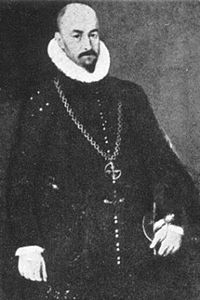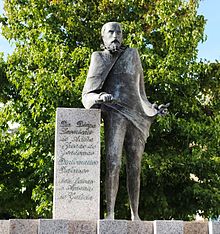- Diego Sarmiento de Acuña, 1st Count of Gondomar
-
 The Conde de Gondomar, title awarded by king Philip III of Spain in 1617, i.
The Conde de Gondomar, title awarded by king Philip III of Spain in 1617, i.
Don Diego Sarmiento de Acuña, Count of Gondomar (es: Don Diego Sarmiento de Acuña, conde de Gondomar) (Gondomar, Galicia November 1, 1567 – Casa la Reina, Logroño, October 2, 1626), was a Galician (Spanish) diplomat, the Spanish ambassador to England in 1613 to 1622 and afterwards, as a kind of ambassador emeritus, as Spain's leading expert on English affairs until his death.[1] The popular notion in England of his day painted him as privy to the inner thoughts of James I and VI, a fiendish schemer for Popery for whom "Machiavellian" was brought into common English usage and the head of a "Spanish" faction at the English court.
Contents
Early life
The eldest son of Garcia Sarmiento de Sotomayor, corregidor of Granada, and governor of the Canary Islands, by his marriage with Juana de Acuña, an heiress, Diego Sarmiento was born in Gondomar, Galicia. He inherited large estates both in Galicia and in Old Castile. In 1583 he was appointed by King Philip II of Spain to the military command of the Portuguese frontier and sea coast of Galicia. He is said to have taken an active part during the Anglo-Spanish War in repelling an English raid on the coast in 1585, and in defending A Coruña against an unsuccessful English attack by Sir Francis Drake and the "English Armada" in 1589. In 1593 he was named corregidor of Toro. In 1603 he was sent from court to Vigo to superintend the distribution of the treasure brought from America by two galleons, which were driven to take refuge there, and on his return was named a member of the board of finance. In 1609 he was again employed on the coast of Galicia, this time to repel a naval attack made by the Dutch. Although he held military commands, and administrative posts, his residence was at Valladolid, where he owned the Casa del Sol and was already collecting his fine library. He was known as a courtier, and apparently as a friend of the favourite, the Duke of Lerma. In 1612 he was chosen as ambassador in England, but did not leave to take up his appointment till May 1613.
The embassy to London
His reputation as a diplomat, which brought him to historical prominence, is based on his two periods of service in Britain from 1613 to 1618 and from 1619 to 1622. The excellence of his latinity pleased the literary tastes of James I, whose character he judged with remarkable insight. He flattered the king's love of books and of peace, and made skilful use of his desire for a matrimonial alliance between the Prince of Wales and the infanta Maria Anna of Austria , the "Spanish Match".
The ambassador's task in the prelude to the Thirty Years' War was to keep James from aiding the Protestant states against Spain and Habsburg Austria, and to avert English attacks on Spanish possessions in The Americas. His success made him odious to the anti-Spanish and Puritan parties. The active part he took in promoting the execution of Sir Walter Raleigh aroused particular animosity. He was attacked by popular pamphleteers— Thomas Scott's extravagant propaganda, Vox populi was widely believed— and the dramatist Thomas Middleton made him a principal character in the strange political play A Game at Chess, which was suppressed by order of the council.
 Portrait of Gondomar, engraving by Simon de Passe, 1622
Portrait of Gondomar, engraving by Simon de Passe, 1622
Gondomar's friends at court, the bien intencionados of his dispatches centered upon the Howards, Henry Howard, 1st Earl of Northampton (died 1614), Thomas Howard, 1st Earl of Suffolk, Lord High Treasurer, whose daughter was married to James's favourite, Charles Howard, 1st Earl of Nottingham, Lord High Admiral, Thomas Howard, 21st Earl of Arundel, and their protegés. The "Howard faction" preferred a marriage alliance with Spain over one with France, the traditional ally of Scotland, and they preferred to keep out of open warfare with Spain promoted by the more zealous Puritans. Most of the Howards were Catholics, encouraging them towards a spirit of toleration at home. Like many at the English court, they were receiving pensions from Spain,[2] without much effect on their opinions and actions, and Gondomar seldom had the money to follow through. Among the pensioners, in an embarrassing list that surfaced in 1613, at Gondomar's first arrival was the King of England himself.
Gondomar conceived his embassy as a sortie in enemy country, and took for his maxim aventurar la vida y osar morir— "risk your life and dare to die"; his opening challenge was his refusal to strike the colours of Spain at his warships' entry to Portsmouth harbour, in which an appeal to the King averted an exchange of cannonfire that would have sunk the ambassador in his vessel. His handling of the unconditional release of the Catholic agitator Luisa Carvajal y Mendoza further established him in James's eyes as a man of unexpected strengths. In 1617 Sarmiento was created Count of Gondomar. The key to Gondomar's success was his relationship with James, whom he brought to admire and like his witty and learned companionship, his candour, within the obvious limits, and his personal integrity. They called themselves the "two Diegos" and drank from the same bottle (Carter 1964:205).
A key program for Gondomar at the outset was to block the marriage negotiations between Prince Charles and a sister of Louis XIII, a French counterweight to marital alliances being concluded with the Spanish Habsburgs.
For more details on this topic, see Spanish Match.In the matter of Sir Walter Raleigh, it was Gondomar's pressure that lost Sir Walter's head, 29 October 1618. In a moment of weakness James had shown Gondomar the contract under which Raleigh had sailed, the restriction upon attacking Spanish settlements, in order to mollify his objections to an enterprise on which James had set his heart. Raleigh's attack on San Thomé (near modern Ciudad Guayana) was a public violation. His execution kept the peace with Spain. The English could not forgive Gondomar, who in 1618 obtained leave to come home for his health, but was ordered to return by way of Flanders and France with a diplomatic mission.
In 1619 he returned to London, and remained till 1622. The Guyana expedition of Roger North in 1620 seemed to be a repeat of Raleigh's violation of Spanish settlements in the Caribbean, and at Gondomar's insistence North was imprisoned.
The tensest late confrontation was over Count Mansfeld's projected movement of troops raised in England to rescue James's son-in-law Frederick V, Elector Palatine, the "Winter King" of Bohemia. Habsburg Madrid and Brussels were concerned that the French aimed to join Mansfeld's forces and retrieve Artois for France, and the project was let slide.
When Gondomar was allowed to retire, on his return to Spain he was named a member of the royal council and governor of one of the king's palaces, and was appointed to a complimentary mission to Vienna. Gondomar was in Madrid when the prince of Wales— afterwards Charles I— made his journey there in search of a wife. He died at the house of the Constable of Castile, near Haro in the Rioja.
Gondomar was twice married, first to his niece Beatrix Sarmiento, by whom he had no children, and then to his cousin Constanza de Acuña, by whom he had four sons and three daughters. The hatred he aroused in England, which was shown by widespread mockery of an intestinal complaint from which he suffered for years, was a tribute to the zeal with which he served his own master.
Gondomar collected, both before he came to London and during his residence there, a fine library of printed books and manuscripts. Orders for the arrangement, binding and storing of his books in his house at Valladolid appear frequently in his voluminous correspondence. In 1785 the library was ceded by his descendant and representative the marquis of Malpica to Charles III of Spain, and it is now in the Royal Library at Madrid.
A portrait of Gondomar, attributed to Diego Velázquez, was formerly at Stowe, Buckinghamshire. It was mezzotinted by Robert Cooper.
1911 Encyclopædia Britannica Authorities
Gondomar's missions to England were largely dealt with in Samuel Rawson Gardiner's History of England (London, 1883–1884) and more recently in Glyn Redworth, The Prince and the Infanta: The Cultural Politics of the Spanish Match (New Haven, 2003).
In Spanish, Don Pascual de Gayangos wrote a useful biographical introduction to a publication of a few of his letters--Cinco Cartas politico-literarias de Don Diego Sarmiento de Acuña, conde de Gondomar, issued at Madrid in 1869 by the Sociedad de Bibliófilos of the Spanish Academy; and there is a life in English by F.H. Lyon (1910).
Notes
- ^ Charles H. Carter, "Gondomar: Ambassador to James I" The Historical Journal 7.2 (1964), pp. 189-208.
- ^ Carter 1964:193, 195. The pensions had been instituted with the first Spanish embassy to James, to the annual tune of £9125. Gondomar, with an English reputation as a spymaster, actually spent a paltry average of £350 for information.
References
 Chisholm, Hugh, ed (1911). "Gondomar, Diego Sarmiento de Acuña, Count of". Encyclopædia Britannica (11th ed.). Cambridge University Press.
Chisholm, Hugh, ed (1911). "Gondomar, Diego Sarmiento de Acuña, Count of". Encyclopædia Britannica (11th ed.). Cambridge University Press.- Charles H. Carter, "Gondomar: Ambassador to James I" The Historical Journal 7.2 (1964), pp. 189–208.
Spanish nobility New title Count of Gondomar
1617-1626Succeeded by
Categories:- 1567 births
- 1626 deaths
- Spanish nobility
- Counts of Gondomar
- Spanish diplomats
- Ambassadors of Spain
- Ambassadors to England
- Spanish academics
Wikimedia Foundation. 2010.
Look at other dictionaries:
Diego Sarmiento de Acuña, conde de Gondomar — Don Diego Sarmiento de Acuña, Count of Gondomar (es: Don Diego Sarmiento de Acuña, conde de Gondomar ) (Gondomar, Galicia November 1, 1567 ndash; October 2, 1626), was a Spanish diplomat, the Spanish ambassador to England in 1613 to 1622 and… … Wikipedia
A Game at Chess — is a comic satirical play by Thomas Middleton, first staged in August 1624 by the King s Men at the Globe Theatre, notable for its political content. The playThe drama seems to be about a chess match, and even contains a genuine chess opening:… … Wikipedia
James I — 1566 1625, king of England and Ireland 1603 25; as James VI, king of Scotland 1567 1625 (son of Mary Stuart). * * * I born 1394 died Feb. 20/21, 1437, Perth, Perth, Scot. King of the Scots (1406–37). The son and heir of Robert III, he was… … Universalium
Liste des chevaliers de l'ordre de la Toison d'or — Le collier de l’ordre de la Toison d’or L ordre de la Toison d or est un ordre de chevalerie séculier fondé en janvier 1430 par Philippe le Bon à Bruges lors des festivités données à l occasion de son mariage avec sa troisième épouse, Isabelle de … Wikipédia en Français

